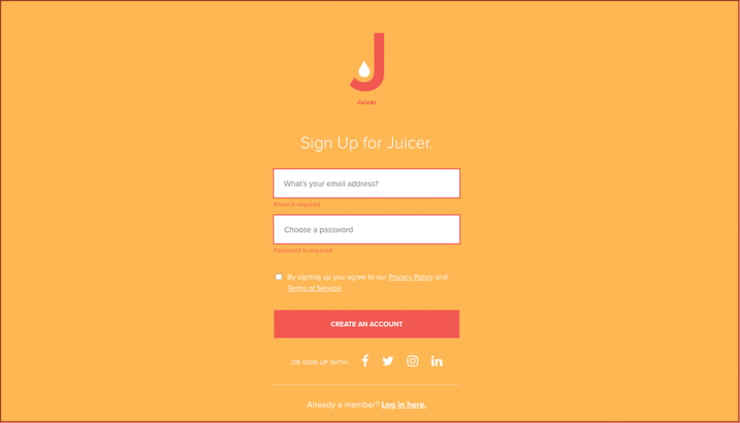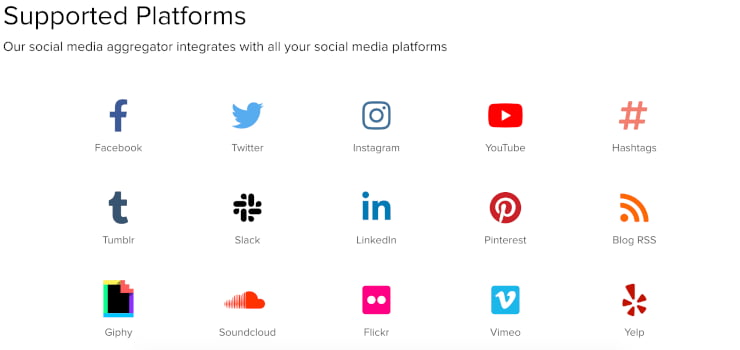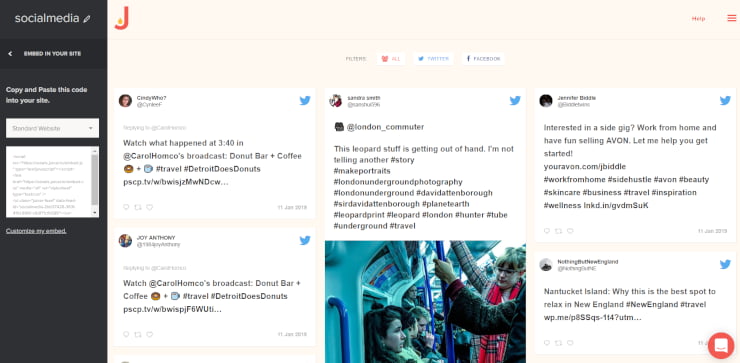There is a lot of content populating the vast expanse of the internet, but you would be surprised how much of it you would miss if you weren’t looking in the right places. While there are many ways to dig up the content you’re looking for, gathering content using aggregator websites is by far one of the fastest, easiest, and cheapest ways to do so.

What is content aggregation? Content aggregation is the automated process of collecting content from specific sources about a particular topic using a tool or aggregator website. For example, you could use a content aggregator website to gather news articles about your brand autonomously. Or you could use an aggregator service to compile social media posts from all of the social networks that use a certain hashtag keyword.
One of the wonderful aspects of accumulating content using an aggregator website is the fact that its applications are only as limited as your creativity.
When you use online aggregators like Juicer, you can build custom aggregators to fit your needs with an arsenal of 15 different sources to aggregate content. Juicer supports content aggregation using Facebook, Twitter, Instagram, YouTube, Tumblr, Slack, LinkedIn, Pinterest, Giphy, SoundCloud, Flickr, Vimeo, Yelp, RSS Feeds, and social media hashtags.
What are the benefits of using a content aggregator site?
Using a content aggregator site has many advantages including the ability to monitor your competitors’ online marketing strategies, collect user-generated content about your brand, learn more about your target audience, and more. Not to mention the fact that it saves you and your team time in your busy schedules since you don’t have to go looking for the online content, it’s gathered for you automatically.
In this guide, we’ll show you how to get started using a content aggregator website like Juicer, a few possible use cases for the content you collect from different sources, and the benefits of each.
How to Setup a Content Aggregator Website
Setting up a content aggregator website is quick and easy. Here, we’ll walk you through the steps to get your content aggregation feed up and running in minutes.
Sign Up for a Juicer Account and Choose Your Aggregated Content Sources
Start by signing up for a free Juicer account by entering in your email address and password.

Select a name for your Juicer feed and then “Add Social Media Source” and choose the icon for the source(s) you want to use for your content aggregator. If you’re choosing a social network or a site where you have an account, the platform will then direct you to confirm your username and access permissions. Once you confirm, you can just sit back and watch as Juicer automatically populates your Juicer dashboard with the content you’re looking for!

Embed Your Juicer Code into Your Website
On the panel located on the left-hand side of the Juicer dashboard, go to “Embed In Your Site” and click on your customized URL. Then, you can copy and paste your aggregator code into your web pages.

Log into your site management console and embed the Juicer code into any page you like! We told you it was easy!
Also Read: Benefits and a list of best business news aggregator websites
Content Aggregation Ideas for Different Sources
Since there are several options regarding the source of your aggregated content, let’s examine the various ways each channel’s content can be utilized for your aggregation marketing strategy.
*One important thing to keep in mind is that you can pick and choose from each of these sources when aggregating content and aren’t limited to just including one platform in your feed of aggregated content.
Facebook:
Content aggregation ideas:
- Aggregate Facebook posts on your brand’s Facebook page to share what people are saying about your brand, products, or services right on your website.
- Create a feed of Facebook content designed to track negative comments so they can be resolved in a timely manner.
- Put together an aggregation of competitor Facebook content to observe and learn from how your competitors are posting on Facebook.
Twitter:
Content aggregation ideas:
- Create your own Twitter news feed to learn more about what people are discussing about a particular topic or industry.
- Collect a feed from your Twitter Support account to make it easier for customer support employees to quickly address and resolve customer grievances.
- Use an aggregator to set up a live feed tracking posts from multiple Twitter accounts for all of the companies involved in an event.
Instagram:
Content aggregation ideas:
- Create a feed of Instagram images of your product being used by real customers to share on your website.
- Generate an aggregated influencer feed to monitor the Instagram posts of influencers your brand works with.
- To create a social media wall for a wedding or large event, use Instagram posts from specific accounts or a designated hashtag.
YouTube:
Content aggregation ideas:
- Create a feed of YouTube videos featuring a closer look at your product and how to use it.
- Share YouTube videos of customer testimonials on your website or even on a specific product page.
- Aggregate a feed of YouTube videos for troubleshooting your products or services and display that feed on a support page on your website.
Tumblr:
Content aggregation ideas:
- Aggregate Tumblr posts that include your brand to include on your website.
- Collect Tumblr posts from influencers or competing brands to monitor and use as inspiration for future posts.
- Accumulate Tumblr posts from a particular audience or category to learn more about what’s trending online.
LinkedIn:
Content aggregation ideas:
- Follow LinkedIn Group updates to learn more about what people are talking about.
- Track any mention of your brand or company in a post on LinkedIn.
- Put together a feed that aggregates the LinkedIn posts from your company’s employees to ensure everyone stays on brand.
Pinterest:
Content aggregation ideas:
- Share a feed of your brand’s Pinterest board content on relevant pages of your website to show off your product in a new light.
- Aggregate a list of Pinterest pins shared by your competitors to learn more about how their brands are engaging with Pinterest marketing.
- Generate a feed of Pinterest pins for inspiration for your next big event, product launch, or marketing campaign.
Slack:
Content aggregation ideas:
- Automate the collection of any messages using a specific keyword or tag to funnel them into an easy-to-view list of action items for a team member or client.
- Easily collect all of the shared images in Slack to view in one place.
- Use a feed of Slack messages to offer status updates for support tickets or projects in progress to share with customers or clients so they can view the current situation.
Giphy:
Content aggregation ideas:
- Generate a feed of GIFs to browse what’s currently trending online.
- Start a contest challenging your fans to create a GIF for your brand and aggregate the submissions to share on your website.
- Put together a feed of GIFs to browse for use in your email campaigns or other marketing messages.
SoundCloud:
Content aggregation ideas:
- Populate a list of SoundCloud submissions for a contest to create a new jingle for your store.
- Collect a list of tracks from artists your company works with.
- Share a library of podcasts your company puts together monthly.
Flickr:
Content aggregation ideas:
- Create a beautiful library of your photography studio’s work to display on your website.
- Generate a library of images to sift through when looking for images to include in email newsletters, blog posts, or social media posts. (Be sure to get the proper permissions before using other people’s images!)
- Display an aggregated Flickr feed that shows all of the images people share from your company’s events and functions.
Vimeo:
Content aggregation ideas:
- Share a feed of video testimonials from your past customers making the reviews a more genuine and authentic experience for potential customers.
- Create a feed of videos from your latest event to add to your website.
- Add a website feed of unboxing videos for your product.
Yelp:
Content aggregation ideas:
- Collect and share all of the Yelp reviews for your business and add them to your website.
- Generate a library of the images and videos customers have added to Yelp to share in a website feed or to use in future social media content.
- Populate an aggregated feed of Yelp reviews to monitor for negative reviews so you can address them and hopefully get the reviews changed or removed.
RSS Feeds:
Content aggregation ideas:
- Automate the collection of all of your competitor’s blog posts to see what they are talking about and how you can learn from their content.
- Generate a list of any mentions of your brand in an online publication or blog.
- Build your own news aggregator for gathering stories about a topic or industry you’re interested in.
Social Media Hashtags:
Content aggregation ideas:
- Easily create a feed of social media posts and pictures for an event or wedding that can be shared with guests.
- Build a feed of social media posts mentioning your brand to engage with your audience.
- Curate content to follow what’s trending for a specific hashtag to learn more about what people are talking about online.
There are so many ways your business or brand can benefit from incorporating a content aggregator website into your marketing and day-to-day business operations. The use cases for content aggregator websites are practically endless and can be molded to fit your business’s unique needs. Does your business or brand use a content aggregator website in a unique way we didn’t mention? Let us know, and we’ll include your idea on our list!
Have a look at the following solutions Juicer.io offers:
- How to embed Twitter feeds, accounts or Tweets on any website
- How to embed Instagram posts, accounts and reels
- How to embed Linkedin feeds
- How to add Youtube videos to your website or blog
- How to embed TikTok Video Feeds on any website
- How to add Facebook posts and feeds to your website
- WordPress plugin for social media feeds
- Embed any social media feed on Wix, Squarespace, Tumblr, Shopify and WebFlow sites
